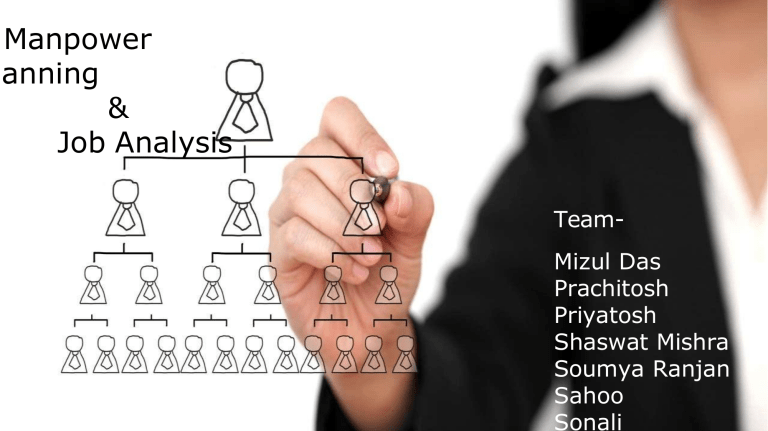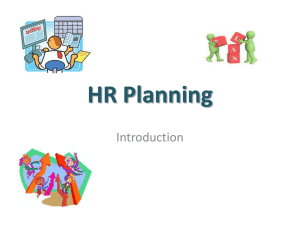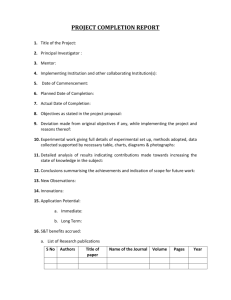
Manpower anning & Job Analysis TeamMizul Das Prachitosh Priyatosh Shaswat Mishra Soumya Ranjan Sahoo Sonali Contents • Concepts • Objectives • Characteristics • Importance • Types of manpower planning • Process • Example • Factors affecting manpower planning • Advantages • Job analysis • Job description • Exampl e • Job specification • Types of job analysis • Job analysis program and its uses • Methods of collecting job analysis information MANPOWE R PLANNING Meaning Manpower planning is the process which includes forecasting, developing and controlling by which a firm ensures that it has: The right number of people. The right kind of people At right place At right time. Manpower planning is also known as personnel planning or human resource planning. Concept Manpower planning involves two stages: planning of manpower requirements planning of manpower supplies Objectives To utilize the present employees fully. To fill up future manpower requirements. To check the development of the employees for organizational growth. To achieve organizational goals in an efficient way. To manage and utilize resources properly and effectively. Characteristics Future oriented. Continuous process Optimum utilization of human resources Right kinds and numbers Determination of demand and supply Environmental influence Importance The first step towards manpower management. Using available assets for the implementation of the business plans. Coordinates and controls various activities in the organization. Efficient utilization & skilled labour. Higher productivity. Types of manpower planning Types of manpower planning can be distinguished: On the basis of the level at which it is done. On the basis of the period for which it is Manpowe done. r Plannin g On the basis of level Macro-level (national level) Micro-level (industrial unit level) On period basis Shor t perio Mediu m period Long period Types of manpower planning (contd.) Level based manpower planning : National level (macro level) • • central government plans for human resources for the entire nation. It anticipates the demand for and supply of human requirements at national level. e.g. Government sectors Industrial level (micro level) • In this level, planning is done to suit manpower needs of a particular industry. e.g. engineering, heavy industries, paper industries, public utility, textile/chemical industries Types of manpower planning (Contd.) Period based manpower planning : Short term • Prepared for a period of 1 year • This types of plans are made as a part of 5 years plans at national level. • Useful at company level. Medium term • Made for 2 to 5 years • Prepared as a financial planning at national level • For employment opportunities and training and development of employees. Long term • Made for 10 to 15 years. • Estimates man power needs of a nation • Rises educational and training Process Demand forecasting Supply forecasting Existing inventory Analysis of the corporate and unit level strategies Recruitme nt & selection Redeployme nt Redundancy / Estimating net manpower requirement Example Manpower planning of Infosys : •Strategy planning, •Employee search, •Screening through Interviews, •Evaluation about a person Manpower planning of McDonalds : • Outsourcing the demand to local recruitment agencies. • Each position has a job description outline. • Career fairs. • Local job centres. • Offers online applications for the applicants to manage the labour supply for its outlets. Factors affecting manpower planning Product mix : • Optimum productive capacity and sales forecast • Optimum utilization of human and material resources Performance mix : • Depends upon the working conditions, bonus schemes, suitable incentive plan, training program, motivation etc. • Motivation directly proportional to performance rate and inversely proportional to the labour capacity Hour lost : • If productive man hours lost are less, there available productive hours will be more and less manpower will be needed. Advantages Manpower planning ensures optimum use of available human resources. It is useful both for organization and nation. It generates facilities to educate people in the organization. It brings about fast economic developments. It boosts the geographical mobility of labor. JOB ANALYSIS & DESCRI P TION Job analysis • It is the first step in job evaluation and requires investigation of each job skills and personal attributes required to perform the job satisfactorily. • Determination of duties and positions and characteristics of the people to hire for the company. Job description Job description indicates what all a job involves. It includes: Job title Job location Job summary Working condition Reporting to Job duties Machines to be used Hazards Example for nursing superintendent • She will be responsible and overall In-charge of Nursing Services in a hospital or specialized centres irrespective of the number of beds. • She will carry out regular rounds of the hospital. • She will ensure safe and efficient care rendered to patients in various wards etc. • She will prepare budgets for nursing services. • She will be a member of various condemnation boards for linen and other hospital stores. • She will be responsible for counselling and Job specification Refers to what kind of people to hire for the job Personal characteristics Physical characteristics Mental Types of Job analysis Task based : Tas k Dut y Responsibil ity Competency based : Individual capabilities that can be linked to enhanced performance by individuals or teams. Technical competencies Behavioral competencies Job analysis program and its uses Recruitment and replacement Better utilization of workers Job restructuring Vocational Counselling Training Performance evaluation Occupational safety Methods of collecting Job analysis information Interview Questionnaires Observation Participant Diary/Logs Quantitative Job Analysis Techniques Using Multiple Sources of Information




